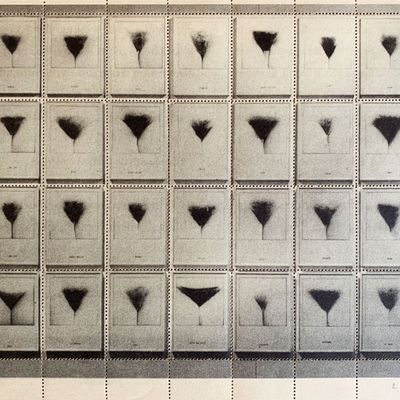
As Marcel Duchamp never said, “Ceci n’est pas une row of pubes.” Or maybe he did — we don’t know for sure. In fact, there’s much about the meticulously arranged rows of pubes pictured here that we don’t know. More than we do know. But look closely at this grid of 36 tiny photos and tell me what you see. If your answer is “a sheet of stamps” or something “possibly surrealist, but also possibly from an American Japanese artist like Yoko Ono,” I’m going to assume that you’re Untitled (36 photographs of montes veneris)’s new owner, Joel Smith, curator of photography at the Morgan Library. The library acquired the piece at the Outsider Art Fair last weekend.
The grid is immediately striking because of the subject matter, but coupled with the mystery of where it came from, when, and from whom, and combined with the level of precision and possibly obsession used to perfectly align all of these bushes in a row, it creates an art world personality test. What do these pubes say about you?
“It’s really a Rorschach test for whoever is looking at it whether you want to concern yourself with the historical origin of it or just be impressed by it,” Smith said. I was slightly embarrassed because when I saw it, all I thought was “oh wow, it’s not every day you see a lineup of pubes.” What else is there to see?
A lot. And Smith very kindly broke it down for me. Let’s start with what this image definitely is: It’s an 8 by 12 inch sheet of stamps, carefully perforated. It’s a sheet of stamps made from one photograph, which is of 36 photographs of vulvas, each in their own frame and arranged in a grid (there are captions for each one, but they are too blurry to read). The grid corresponds to the perforations of the stamps. The term for a reproduction of stamps that isn’t issued by the post office is a Cinderella. Smith finds this to be fascinating in relation to the mons pubis. “The tale of Cinderella makes a story out of the way women are encouraged to obsess over details of their anatomy — the dainty foot that will fit the glass slipper and reveal its owner as a princess. The images in these stamps aren’t organized in any discernible way; their collective effect is to show that women are various, and that any canon or standard for how they “should” be will fall short of the facts.”
So there’s that, but Smith is careful not to make any assumptions about the photo as a part of a wider artistic movement. He says visually it could be surrealist, like a Duchamp, because of its organization, repetition, and shock value. It could be a Fluxus piece, from the international art movement that included Yoko Ono and was popular in the ’60s and ’70s. But therein lies another wrinkle: the previous owner told the library that they had tested the piece and concluded that it was from around the 1930s (after Duchamp’s most influential years and well before Ono’s).
Maybe it’s just a cheeky diagram meant to compare the various hairstyles to different objects. “People can look at it and think they’re trees or umbrellas blown up by the wind. And there’s something striking about that,” Smith said. That each smaller image sort of looks like something else if you’re not looking too hard could definitely be the point; if you used one of these stamps on a thank-you note to Aunt Dory, she might be shocked to receive an obvious vulva in the mail.
Some might find it unsatisfying not to know who the artist is or where this delightful little sheet came from. Personally, I think the best part is imagining the person who was organized enough to take 36 nearly identical photos, caption them, hang them meticulously in a grid, take another photo, and then turn it into a sheet of stamps. Isn’t that lovely? If you know anything about these pubes, please contact me at sarah.spellings@nymag.com. I’ll be thinking about them for a long time.




